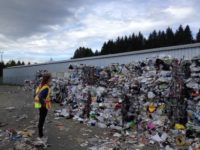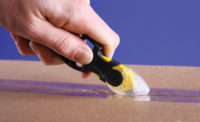Throwing household waste such as small batteries, cleaning products, and light bulbs in the trash may not be environmentally friendly behavior, but in most cases, it’s not against the law. However, businesses face many more limitations and regulations on what can and can’t be thrown away. Federal and state laws require businesses to make a waste determination on their waste streams and manage them accordingly.
Take an aerosol can, for example. It might be perfectly fine to throw an empty can into the trash at home. At work, however, it’s a different story. Other items that could present disposal issues include fluorescent light bulbs, cleaning solutions, solvents, and various chemicals. How you go about disposing of these “household” items will depend on several factors, including your hazardous waste generator category, the program you’re managing the waste under, and your state regulations.
Before you throw it away…
A lot goes into the correct disposal of items in the workplace. Before you can make the right decision, you need to take the following five steps:
- Perform a waste survey
- Make a hazardous waste determination
- Know your generator category
- Decide which program covers the waste
- Learn your state regulations
Step 1 — Perform a waste survey
A waste survey is an important step at any workplace — whether you’re a manufacturer, auto refinisher, school, service-provider, or office park. The survey involves identifying all the wastes — hazardous and non-hazardous — at your facility. Remember that if you’re still using something, it’s not a waste and should not be included in your survey.
Your survey should identify all your waste streams, which will include your “trash,” solid waste, hazardous waste, and any special waste such as used oil, compact fluorescent lights, and batteries.
How you perform the waste survey will depend in large part on your industrial or nonindustrial activities, the kind of processes you use, your raw materials, and many other factors. It’s a good idea to include employees in the waste survey. They can often identify waste streams you may have overlooked and will play a large role in making sure waste is directed correctly.
Step 2 — Make a hazardous waste determination
Once you’ve identified your waste streams, you need to know which, if any, are hazardous waste. Hazardous waste is highly regulated and must be managed correctly.
The Environmental Protection Agency says a hazardous waste is a waste with properties that make it dangerous or capable of having a harmful effect on human health or the environment.
Under the regulatory definition of hazardous waste, a waste first must be a solid waste. A solid waste is defined as a solid, liquid or even a gas that is:
- Abandoned,
- Recycled,
- Considered inherently waste-like, or
- A military munition.
The regulations exclude certain wastes from the solid waste definition because they are regulated under other federal programs. Examples include domestic sewage, radioactive wastes, and industrial wastewater discharges.
If your solid waste is not an excluded solid waste, may be a hazardous waste if it is:
- Not specifically exempted from the definition of a hazardous waste or managed under less strict regulatory programs. Examples of exempted wastes include household hazardous waste, used cathode ray tubes, used oil, certain used refrigerants, universal wastes, and lab samples.
- Listed in one of four lists in the regulations at 40 CFR 261 Subpart D.
- Exhibits one of the following hazardous characteristics: ignitability, corrosivity, reactivity, and/or toxicity.
Step 3 — Know your generator category
Federal law divides hazardous waste generators — those that produce hazardous waste — into three distinct categories:
- Large quantity generators (LQGs),
- Small quantity generators (SQGs), and
- Very small quantity generators (VSQGs).
The amount of hazardous waste you generate each month affects your disposal options. The more hazardous waste you generate, and the more you accumulate on site, the more regulated you are.
LQGs and SQGs have strict accumulation time limits, in addition to container management, emergency preparedness, manifesting, and reporting requirements. They must train employees to manage the waste safely and to prevent releases. These generators must send their hazardous waste to federal or state permitted treatment, storage, and disposal facilities.
VSQGs have more, and less expensive, options for shipping waste offsite. Along with permitted facilities, generators of very small amounts of hazardous waste may send their waste to a facility authorized by the state, an authorized municipal solid waste landfill, a legitimate recycler, or a large quantity generator under the control of the same person (under certain conditions).
Step 4 — Decide which program covers the waste
You can manage some common waste streams under less stringent regulatory programs. Examples include used oil and universal wastes — such as batteries — and compact fluorescent light bulbs (called lamps in the regulations). Note that if you don’t manage these wastes correctly, you may have to manage them as hazardous waste.
The advantage to using these alternate programs is that you have more time to accumulate the waste and fewer management requirements.
Step 5 — Learn your state regulations
Almost every state runs its own solid and hazardous waste program. These programs must be at least as stringent as the federal regulations; in many cases, they are more stringent. For instance, California has stricter management requirements in place for used oil than the federal used oil program.
In addition, some states list certain wastes as state-only hazardous waste or have different requirements in place for liquid industrial wastes, special wastes, and universal waste.
Proper waste disposal is not an easy thing for a business, whether it’s solid waste, hazardous waste, or something in-between. Before you decide to throw an item in the trash, be sure it’s not considered a regulated waste.



